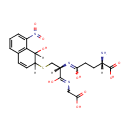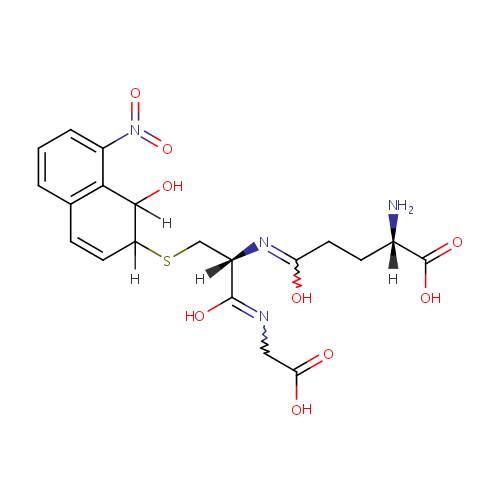|
Record Information |
|---|
| Version |
1.0 |
|---|
| Update Date |
1/22/2018 11:54:54 AM |
|---|
|
Metabolite ID | PAMDB000875 |
|---|
|
Identification |
|---|
| Name: |
1-Nitro-7-glutathionyl-8-hydroxy-7,8-dihydronaphthalene |
|---|
| Description: | 1-nitro-7-glutathionyl-8-hydroxy-7,8-dihydronaphthalene belongs to the class of Peptides. These are compounds containing an amide derived from two or more amino carboxylic acid molecules (the same or different) by formation of a covalent bond from the carbonyl carbon of one to the nitrogen atom of another. (inferred from compound structure) |
|---|
|
Structure |
|
|---|
| Synonyms: | - (2S)-2-amino-5-(2R)-1-(carboxymethylamino)-3-(1-Hydroxy-8-nitro-1,2-dihydronaphthalen-2-yl)sulfanyl-1-oxopropan-2-ylamino-5-oxopentanoate
- (2S)-2-amino-5-(2R)-1-(carboxymethylamino)-3-(1-hydroxy-8-nitro-1,2-dihydronaphthalen-2-yl)sulfanyl-1-oxopropan-2-ylamino-5-oxopentanoic acid
- (2S)-2-amino-5-(2R)-1-(carboxymethylamino)-3-(1-Hydroxy-8-nitro-1,2-dihydronaphthalen-2-yl)sulphanyl-1-oxopropan-2-ylamino-5-oxopentanoate
- (2S)-2-amino-5-(2R)-1-(carboxymethylamino)-3-(1-Hydroxy-8-nitro-1,2-dihydronaphthalen-2-yl)sulphanyl-1-oxopropan-2-ylamino-5-oxopentanoic acid
- L-g-Glutamyl-S-(1-hydroxy-8-nitro-1,2-dihydro-2-naphthalenyl)-L-cysteinylglycine
- L-gamma-Glutamyl-S-(1-hydroxy-8-nitro-1,2-dihydro-2-naphthalenyl)-L-cysteinylglycine
- L-γ-Glutamyl-S-(1-hydroxy-8-nitro-1,2-dihydro-2-naphthalenyl)-L-cysteinylglycine
|
|---|
|
Chemical Formula: |
C20H24N4O9S |
|---|
| Average Molecular Weight: |
496.491 |
|---|
| Monoisotopic Molecular
Weight: |
496.126399076 |
|---|
| InChI Key: |
FCTXJUPCCZHZHU-WXFCVCCESA-N |
|---|
| InChI: | InChI=1S/C20H24N4O9S/c21-11(20(30)31)5-7-15(25)23-12(19(29)22-8-16(26)27)9-34-14-6-4-10-2-1-3-13(24(32)33)17(10)18(14)28/h1-4,6,11-12,14,18,28H,5,7-9,21H2,(H,22,29)(H,23,25)(H,26,27)(H,30,31)/t11-,12-,14?,18?/m0/s1 |
|---|
| CAS
number: |
Not Available |
|---|
| IUPAC Name: | (2S)-2-amino-4-{[(1R)-1-[(carboxymethyl)-C-hydroxycarbonimidoyl]-2-[(1-hydroxy-8-nitro-1,2-dihydronaphthalen-2-yl)sulfanyl]ethyl]-C-hydroxycarbonimidoyl}butanoic acid |
|---|
|
Traditional IUPAC Name: |
(2S)-2-amino-4-{[(1R)-1-(carboxymethyl-C-hydroxycarbonimidoyl)-2-[(1-hydroxy-8-nitro-1,2-dihydronaphthalen-2-yl)sulfanyl]ethyl]-C-hydroxycarbonimidoyl}butanoic acid |
|---|
| SMILES: | [H][C@](N)(CCC(O)=N[C@@]([H])(CSC1([H])C=CC2=C(C(=CC=C2)N(=O)=O)C1([H])O)C(O)=NCC(O)=O)C(O)=O |
|---|
|
Chemical Taxonomy |
|---|
|
Taxonomy Description | This compound belongs to the class of organic compounds known as peptides. These are compounds containing an amide derived from two or more amino carboxylic acid molecules (the same or different) by formation of a covalent bond from the carbonyl carbon of one to the nitrogen atom of another. |
|---|
|
Kingdom |
Organic compounds |
|---|
| Super Class | Organic acids and derivatives |
|---|
|
Class |
Carboxylic acids and derivatives |
|---|
| Sub Class | Amino acids, peptides, and analogues |
|---|
|
Direct Parent |
Peptides |
|---|
| Alternative Parents |
|
|---|
| Substituents |
- Alpha peptide
- N-acyl-aliphatic-alpha amino acid
- 1-nitronaphthalene
- N-acyl-alpha amino acid or derivatives
- N-acyl-alpha-amino acid
- D-alpha-amino acid
- Naphthalene
- Alpha-amino acid or derivatives
- Alpha-amino acid
- Amino fatty acid
- Fatty acyl
- Benzenoid
- Dicarboxylic acid or derivatives
- Organic nitro compound
- Secondary alcohol
- Organic nitrite
- C-nitro compound
- Dialkylthioether
- Organic 1,3-dipolar compound
- Propargyl-type 1,3-dipolar organic compound
- Allyl-type 1,3-dipolar organic compound
- Sulfenyl compound
- Thioether
- Organic oxoazanium
- Carboxylic acid
- Carboximidic acid derivative
- Carboximidic acid
- Hydrocarbon derivative
- Organic salt
- Primary amine
- Organosulfur compound
- Organooxygen compound
- Organonitrogen compound
- Primary aliphatic amine
- Carbonyl group
- Amine
- Alcohol
- Organic cation
- Aromatic homopolycyclic compound
|
|---|
| Molecular Framework |
Aromatic homopolycyclic compounds |
|---|
| External Descriptors |
Not Available |
|---|
|
Physical Properties |
|---|
| State: |
Not Available |
|---|
| Charge: | -3 |
|---|
|
Melting point: |
Not Available |
|---|
| Experimental Properties: |
|
|---|
| Predicted Properties |
|
|---|
|
Biological Properties |
|---|
| Cellular Locations: |
Cytoplasm |
|---|
| Reactions: | |
|---|
|
Pathways: |
Not Available |
|---|
|
Spectra |
|---|
| Spectra: |
|
|---|
|
References |
|---|
| References: |
- Kanehisa, M., Goto, S., Sato, Y., Furumichi, M., Tanabe, M. (2012). "KEGG for integration and interpretation of large-scale molecular data sets." Nucleic Acids Res 40:D109-D114. Pubmed: 22080510
|
|---|
| Synthesis Reference: |
Not Available |
|---|
| Material Safety Data Sheet (MSDS) |
Not Available |
|---|
|
Links |
|---|
| External Links: |
| Resource | Link |
|---|
| CHEBI ID | Not Available | | HMDB ID | HMDB60329 | | Pubchem Compound ID | 11954055 | | Kegg ID | C14804 | | ChemSpider ID | 10128350 | | Wikipedia ID | Not Available | | BioCyc ID | Not Available |
|
|---|


